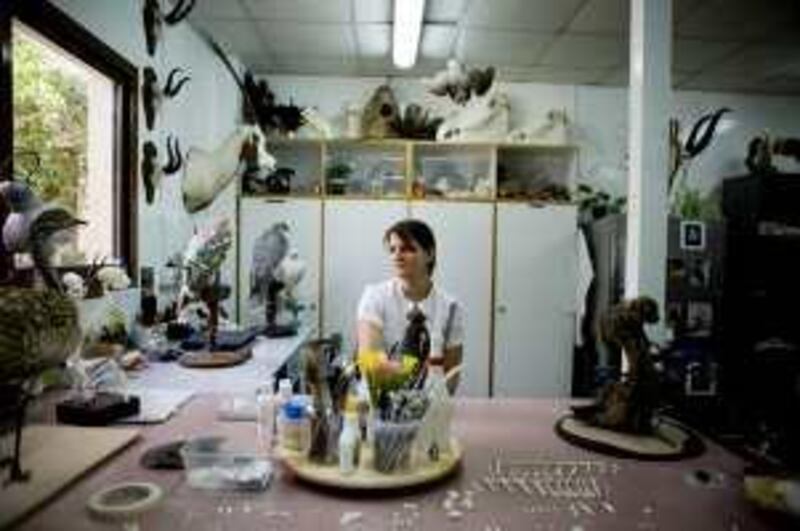DUBAI // "Some people think our work is creepy because we are surrounded by death," Corina Berners says, taking a seat in front of a tiny marmoset monkey set in a metal vice on the table. Glass eyes stare out from the stuffed menagerie that surrounds her: a zebra head, two cheetahs, falcons, houbaras. In the corner, floating in a tub of ethanol, are a couple of baby birds and a small alligator.
"To us, it's artwork," chips in Ms Berners' colleague, Andre Appelt. The taxidermy centre at the Central Veterinary Research Laboratory in Dubai, a diagnostics centre founded by Sheikh Mohammed bin Rashid in the 1980s, has been running since March 2008, when Ms Berners was brought in from Germany. In November, they had to hire two more staff as demand for their services boomed. "They brought me in because they were getting all these rare animals in for postmortems, and it seemed such a shame just to burn them," she says. "At first, it was mostly birds but it has spiralled."
Ms Berners and her small team have stuffed about 150 animals over the past year. About a third are falcons, but rarer requests include jaguars, lions, tigers, leopards, gazelles and a two-toed sloth. "Falcons are so important to Emiratis," says Ms Berners, "They are like children to some of our clients, and if they have a beautiful bird, that's a beautiful hunter, that they've had for 15 years, they feel they just want to keep it ? this is why they come to us."
In November, the staff had one of their most challenging tasks so far ? to stuff the head, neck and shoulders of a fully grown giraffe. "It was really hard, physical work," says Ms Berners. "We were exhausted." The giraffe, like about half the animals the centre receives, was from the private collection of one of Dubai's sheikhs. "He was really attached to the giraffe," she says. "Our clients often have much larger collections than the zoos, and their animals are kept very well."
When an animal is received, particularly if it's a rare breed, the centre always checks its papers to make sure everything is legal. Unlike in Europe, where the hide would be sent off for professional tanning, here the team must do everything themselves. "We would never do such big animals there anymore. Nobody does giraffes, it's too much work," says Ms Berners. "We'd only do restorations, that's why we like working here."
The process isn't cheap, ranging from Dh1,000 (US$270) for a falcon to Dh200,000 to a horse. A falcon takes just a day or two to stuff, but a cheetah can require a month, and a horse or giraffe six weeks or more. The centre employs two methods of taxidermy. For larger animals, the body is meticulously photographed and measured before being skinned. The hide is then stripped, tanned and injected with insecticides. A foam model of the animal is constructed with meticulous detail, copied from photographs and the skinned carcass of the animal, which is kept in a freezer, so that every blood vessel and muscle is in the right place. If a feather is out of place, or the chest of a bird is not puffed up just enough, Ms Berners spots it.
The skeletons are sometimes cleaned and assembled for separate displays. While some might enjoy a jigsaw puzzle in front of the television, Ms Berners grapples with assembling a dugong skeleton in her living room, which she has been working on for the last three or four months. The centre has stuffed a few domestic cats and dogs, but such requests are rare. "We don't really get people coming to us so they can have their favourite cat curled up on the sofa forever," Ms Berners says.
The latest challenge for the taxidermy team is a guanaco-dromedary camel cross, from a local breeding centre, which the staff will begin work on this week. With no information available on the anatomy of the unusual cross, the taxidermists decided to first stuff a guanaco, a South American camelid similar to a llama, and a camel to get better acquainted with the animals. Both Ms Berners and Mr Appelt say their favourite work is for educational institutions such as museums, where their work goes on display to raise awareness of rare species.
Ms Berners holds out a piece of plasticised dugong skin, rough to the touch and covered in coarse wiry hair. "Not many people know that that's what a dugong feels like," she says. "Having something like this can help educate them." @Email:lmorris@thenational.ae






